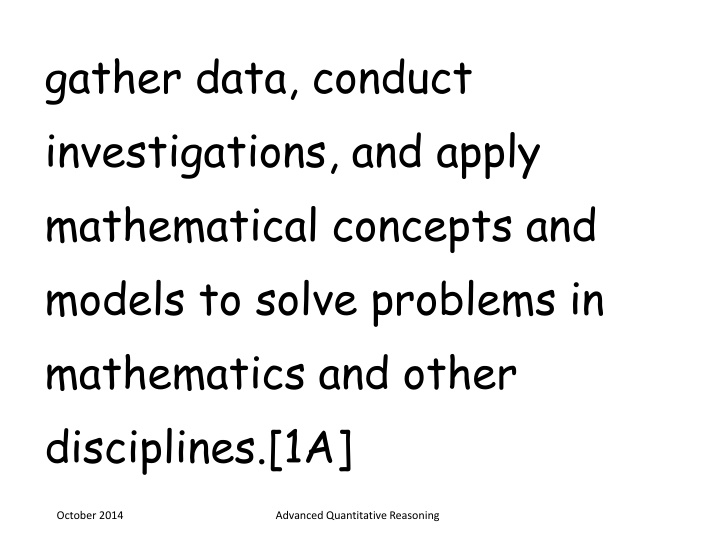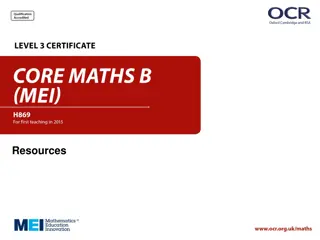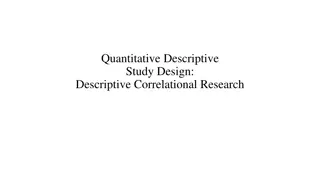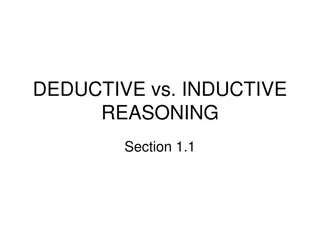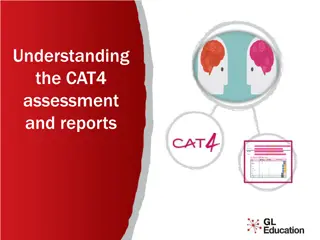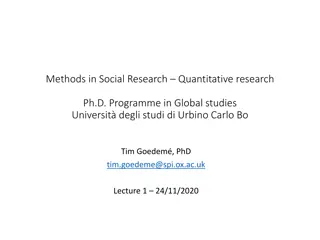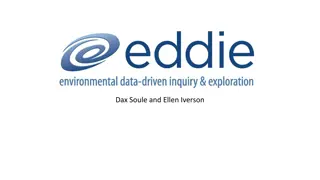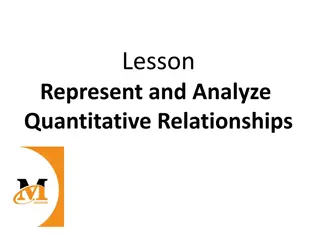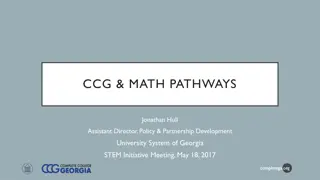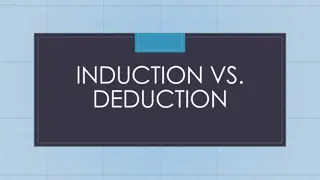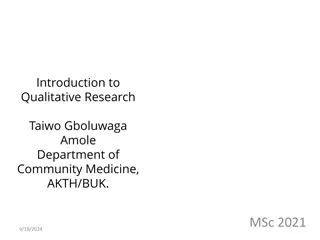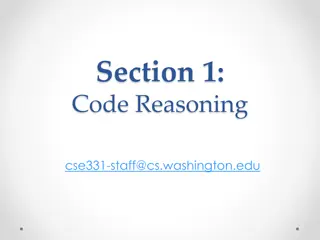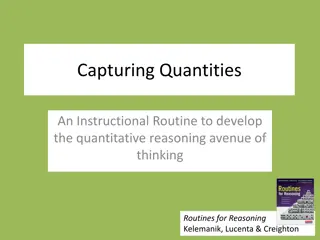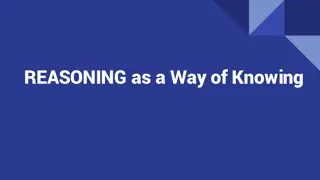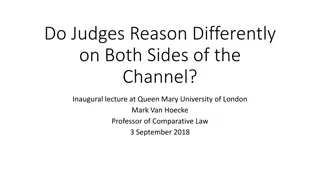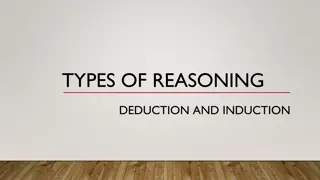Advanced Quantitative Reasoning Overview
This content delves into the application of mathematical concepts to solve problems, enhance reasoning skills, and communicate solutions effectively. It involves analyzing mathematical arguments, using ratios and probabilities to make informed decisions, managing large data sets efficiently, and applying algorithms for error identification in numerical data. The focus is on utilizing mathematical models and tools to tackle real-world challenges across various disciplines.
Uploaded on Sep 30, 2024 | 2 Views
Download Presentation

Please find below an Image/Link to download the presentation.
The content on the website is provided AS IS for your information and personal use only. It may not be sold, licensed, or shared on other websites without obtaining consent from the author.If you encounter any issues during the download, it is possible that the publisher has removed the file from their server.
You are allowed to download the files provided on this website for personal or commercial use, subject to the condition that they are used lawfully. All files are the property of their respective owners.
The content on the website is provided AS IS for your information and personal use only. It may not be sold, licensed, or shared on other websites without obtaining consent from the author.
E N D
Presentation Transcript
gather data, conduct investigations, and apply mathematical concepts and models to solve problems in mathematics and other disciplines.[1A] October 2014 Advanced Quantitative Reasoning
demonstrate reasoning skills in developing, explaining, and justifying sound mathematical arguments, and analyze the soundness of mathematical arguments of others.[1B] October 2014 Advanced Quantitative Reasoning
communicate with mathematics orally and in writing as part of independent and collaborative work, including making accurate and clear presentations of solutions to problems.[1C] October 2014 Advanced Quantitative Reasoning
apply, compare, and contrast ratios, rates, ratings, averages, weighted averages, or indices to make informed decisions.[2A] October 2014 Advanced Quantitative Reasoning
solve problems involving large quantities that are not easily measured.[2B] October 2014 Advanced Quantitative Reasoning
use arrays to efficiently manage large collections of data and add, subtract, and multiply matrices to solve applied problems.[2C] October 2014 Advanced Quantitative Reasoning
apply algorithms and identify errors in recording and transmitting identification numbers.[2D] October 2014 Advanced Quantitative Reasoning
determine and interpret conditional probabilities and probabilities of compound events by constructing and analyzing representations, including tree diagrams, Venn diagrams, and area models, to make decisions in problem situations.[3A] October 2014 Advanced Quantitative Reasoning
use probabilities to make and justify decisions about risks in everyday life.[3B] October 2014 Advanced Quantitative Reasoning
calculate expected value to analyze mathematical fairness, payoff, and risk.[3C] October 2014 Advanced Quantitative Reasoning
identify limitations or lack of information in studies reporting statistical information, including when studies are reported in condensed form.[4A] October 2014 Advanced Quantitative Reasoning
interpret and compare the results of polls, given a margin of error.[4B] October 2014 Advanced Quantitative Reasoning
identify uses and misuses of statistical analyses in studies reporting statistics or using statistics to justify particular conclusions.[4C] October 2014 Advanced Quantitative Reasoning
describe strengths and weaknesses of sampling techniques, data and graphical displays, and interpretations of summary statistics or other results appearing in a study.[4D] October 2014 Advanced Quantitative Reasoning
determine the purpose of a statistical investigation and what type of statistical analysis can be used to answer a specific question or set of questions.[5A] October 2014 Advanced Quantitative Reasoning
identify the population of interest, select an appropriate sampling technique, and collect data.[5B] October 2014 Advanced Quantitative Reasoning
identify the variables to be used in a study.[5C] October 2014 Advanced Quantitative Reasoning
determine possible sources of statistical bias in a study and how such bias may affect the ability to generalize the results.[5D] October 2014 Advanced Quantitative Reasoning
create data displays for given data sets to investigate, compare, and estimate center, shape, spread, and unusual features.[5E] October 2014 Advanced Quantitative Reasoning
determine possible sources of variability of data, including those that can be controlled and those that cannot be controlled.[5F] October 2014 Advanced Quantitative Reasoning
report results of statistical studies, including selecting an appropriate presentation format, creating graphical data displays, and interpreting results in terms of the question studied.[6A] October 2014 Advanced Quantitative Reasoning
justify the design and the conclusion(s) of statistical studies, including the methods used for each.[6B] October 2014 Advanced Quantitative Reasoning
communicate statistical results in both oral and written formats using appropriate statistical language.[6C] October 2014 Advanced Quantitative Reasoning
apply, analyze, and compare various ranking algorithms to determine an appropriate method to solve a real-world problem.[7A] October 2014 Advanced Quantitative Reasoning
analyze and compare various voting and selection processes to determine an appropriate method to solve a real-world problem.[7B] October 2014 Advanced Quantitative Reasoning
determine if there is a linear relationship in a set of bivariate data by finding the correlation coefficient for the data, and interpret the coefficient as a measure of the strength and direction of the linear relationship.[8A] October 2014 Advanced Quantitative Reasoning
collect numerical bivariate data; use the data to create a scatterplot. select a function such as linear, exponential, logistic, or trigonometric to model the data.[8B] October 2014 Advanced Quantitative Reasoning
justify the selection of a function to model data, and use the model to make predictions.[8C] October 2014 Advanced Quantitative Reasoning
analyze and determine appropriate growth or decay models, including linear, exponential, and logistic functions.[9A] October 2014 Advanced Quantitative Reasoning
analyze and determine an appropriate cyclical model that can be modeled with trigonometric functions.[9B] October 2014 Advanced Quantitative Reasoning
analyze and determine an appropriate piecewise model.[9C] October 2014 Advanced Quantitative Reasoning
solve problems using recursion or iteration.[9D] October 2014 Advanced Quantitative Reasoning
determine, represent, and analyze mathematical models for various types of income calculations.[10A] October 2014 Advanced Quantitative Reasoning
determine, represent, and analyze mathematical models for expenditures, including those involving credit.[10B] October 2014 Advanced Quantitative Reasoning
determine, represent, and analyze mathematical models for various types of loans and investments.[10C] October 2014 Advanced Quantitative Reasoning
solve problems involving scheduling or routing situations that can be represented by methods such as a vertexedge graph using critical paths, Euler paths, or minimal spanning trees.[11A] October 2014 Advanced Quantitative Reasoning
construct, analyze, and interpret flow charts in order to develop and describe problem- solving procedures.[11B] October 2014 Advanced Quantitative Reasoning
create and use two- and three- dimensional representations of authentic situations using paper techniques or dynamic geometric environments for computer-aided design and other applications.[12A] October 2014 Advanced Quantitative Reasoning
use vectors to represent and solve applied problems.[12B] October 2014 Advanced Quantitative Reasoning
use matrices to represent geometric transformations and solve applied problems.[12C] October 2014 Advanced Quantitative Reasoning
solve geometric problems involving inaccessible distances such as those encountered when building a bridge, constructing a skyscraper, or mapping planetary distances.[12D] October 2014 Advanced Quantitative Reasoning
